
Print on Demand vs. Do-It-Yourself: Which is Right for You?
Ever wanted a custom item you just couldn't find anywhere? Whether you're making personalized gifts or starting a creative business, you basically have two options: Print on Demand or doing it yourself.
Quick Comparison Overview
Before diving deep into each approach, here's a snapshot of how POD and DIY stack up across key factors that matter most to creators.
| Factor | Print on Demand | Do-It-Yourself |
|---|---|---|
| Startup Cost | Minimal ($0–50) | High ($200–2000+) |
| Time Investment | Low | High |
| Profit Margins | Lower (10–30%) | Higher (40–80%) |
| Quality Control | Platform-dependent | Complete control |
| Scalability | Automatic | Manual expansion |
| Customization | Platform-limited | Unlimited |
What is Print on Demand?
Print on Demand (POD) changes the game with personalized products. Instead of warehousing lots of stuff, goods are only printed when an order comes in. You upload your designs to POD sites, and they take care of everything – printing, shipping, etc.
The best thing is how easy it is. You design something, select what type of products you'd like it printed onto (e.g., t-shirts or shoes), and the POD website handles making it. Many free print-on-demand platforms offer this service without upfront costs.No more worry about a warehouse full of merchandise that you might or might not sell.
POD Perks: Less Risk, Lots of Choices
One of the best things about POD is that you don't need to go bankrupt in order to begin it. You don't have to buy printing equipment, rent storage units, or have a lot of mess floating around. This is great for those who have little money to invest.
POD also gives you plenty of product choices. You are able to make anything from shirts to home products like wall decor, blankets, and doormats. And there are accessories like bags, phone cases, mugs, and jewelry. You can even print your designs on products like shoes.
Scaling up is easy too. If you get more orders,the POD platform just manufactures more products. If there are fewer orders, you don't have to worry about ending up with a lot of leftover products. This makes it easier to try out different product ideas without having to risk much capital.
You also get to have more time for the fun bits, like creating and promoting your brand. Instead of taking care of printing and shipping, you get to focus on making clean artwork and word of mouth.
POD Challenges: The Trade-offs
One of the biggest downsides of POD is that you don't make as much money per sale. The platform takes a cut, and production costs can eat into your profits more than if you did things yourself.
You also have less control over quality. Since you're not printing the items yourself, the quality can be different from order to order. It all depends on the platform's standards, and you can't check the items before they go to your customers.
You might also be limited in how much you can customize your products. Some POD services let you do a lot, like inkedjoy's one-piece and multi-piece design options, but others are more restrictive in terms of where you can put your designs and how big they can be.
Finally, shipping can take longer. Since products are printed when they're ordered, it takes extra time compared to shipping something that's already in stock.

Doing It Yourself: Total Creative Freedom
If you go the DIY (Do-It-Yourself) route, you're in complete control. This means finding your own materials, creating your designs, actually making the items yourself, and handling all the shipping and fulfillment.
DIY can involve all sorts of things, from sewing and painting to screen printing and crafting. Each method has its own benefits, depending on what kind of products you want to make and what your artistic style is.
DIY Advantages: More Profit, Better Quality
If you're willing to put in the work, DIY can be more profitable. Because you're in charge of everything, you get to keep more of the money from each sale, especially as you make more stuff.
You also have the best possible quality control. You can check every item before it goes out the door, making sure everything is perfect and fixing any problems right away.
With DIY, you can customize things however you want. Want to make a t-shirt with a special fabric and design? No problem. Need shoes with hand-painted details that a machine can't do? DIY lets you get that personal.
Plus, there's a satisfaction that comes from making something yourself. It's rewarding to create something beautiful with your own hands, and that's something you don't get when you outsource production.
DIY Drawbacks: Time and Money
One of the biggest challenges with DIY is the initial cost. Depending on how you're making your products, you might need to invest in professional equipment, good materials, and a decent workspace. This can add up before you even start making money.
It's also very time-consuming. You have to handle every step of the process yourself, from designing to packaging. Something that a POD platform could do in minutes might take you hours of work.
Managing inventory can also be tricky. You need to guess how much of each product you'll sell so you don't end up with a bunch of unsold items or run out of popular ones. And as your business grows, you'll need more storage space.
Finally, it can be hard to scale up. There's only so much you can physically produce on your own. To make more, you'll need more equipment, space, and maybe even hire some help.
Head-to-Head: Comparing Both Approaches
The Money Matters
How much capital you have to invest is very different for POD and DIY. With POD, in fact, you don't need very much money at all. But with DIY, you can spend hundreds or even thousands of dollars on materials and equipment.
If you're manufacturing lots of products, DIY can be cheaper on a per-product basis. But this varies with how complicated your products are and how efficiently you can do them. For straightforward products, DIY can be cheaper after several sales. For complicated products, it might take dozens of sales to pay for itself.
Both POD and DIY have associated costs with them. In POD, you will need to bear advertisement and platform charges. In DIY, you will need to bear equipment maintenance, material wastage, and storage.
The Time Investment
POD takes way less hands-on time. Uploading your designs and managing your listings might take a few hours, but not days.The minimal time commitment makes it perfect for running a POD side hustle alongside your main job. DIY can take up your whole weekend just to make a few products.
It also takes different amounts of time to learn each method. You can usually figure out POD platforms in a few weeks with some research and experimenting. But it can take months or even years to get good at DIY and make things that look professional.
The Quality and Customization
With DIY, you have a lot more control over how your final product looks. You get to pay attention to every little detail.
With POD, the quality depends on the platform you choose. Some services have high standards, but you have to trust their quality control.Finding reliable suppliers is crucial for maintaining consistent product quality.
DIY lets you customize things however you want, but you need the skills to do it. POD platforms might limit some of your customization options, but they often have design tools that let you personalize things without being a technical expert.
The Business Growth
How you build your business differs depending on the approach. With POD, your business builds automatically as you receive more orders. You don't do anything else. But with DIY, you have to plan ahead, invest in more equipment, and maybe even get help.
DIY gets a lot more complicated as you grow. You're working with more product, putting together more manufacturing, and you have to maintain the same quality when making more products. It's really hard.
Ready to Start Your Custom Product Journey?
Both DIY and POD have their advantages and disadvantages, depending on what you are after. Which is for you depends on the amount of money you can spend and the amount of time you can spare, how important quality is to you, and what your future plans are. Start off small, try out the method you select, and remember that most successful artists utilize both methods as their businesses grow.



